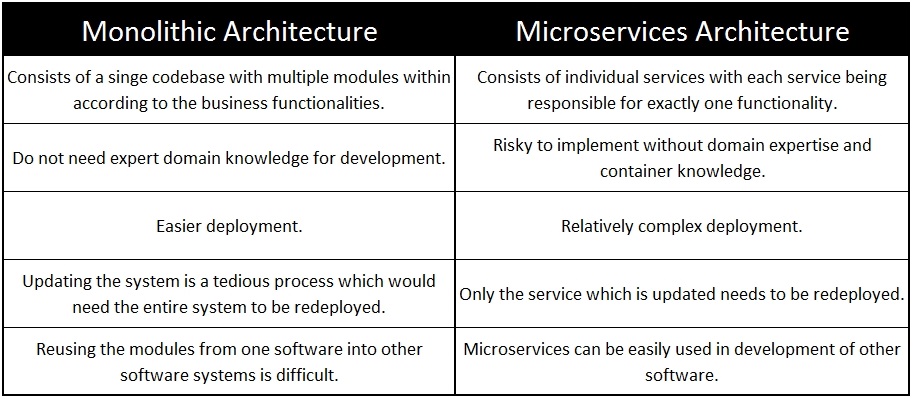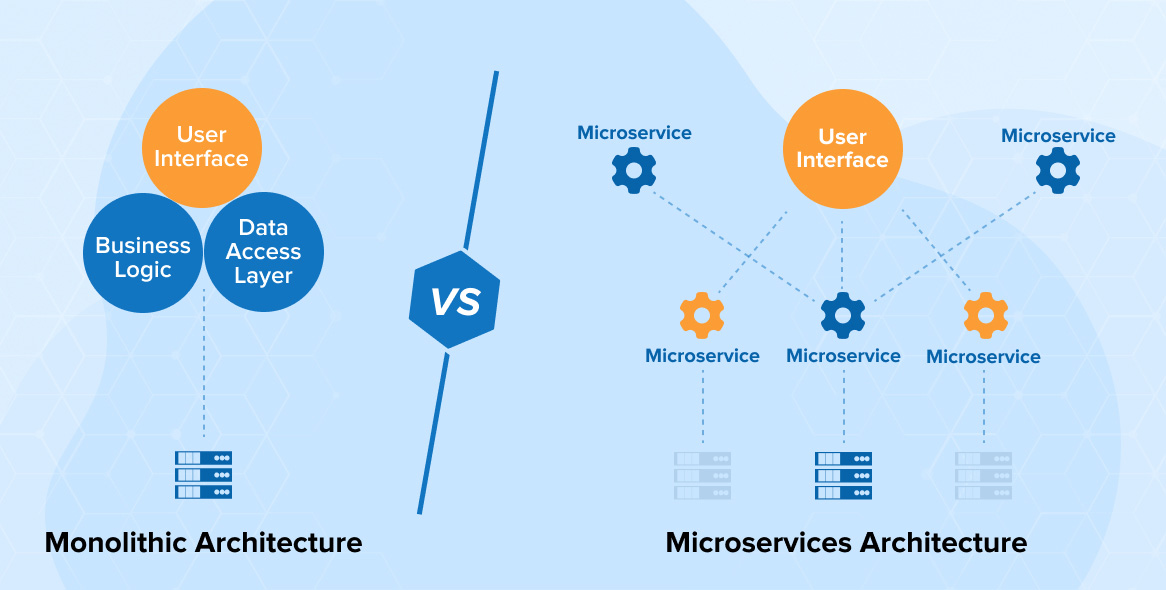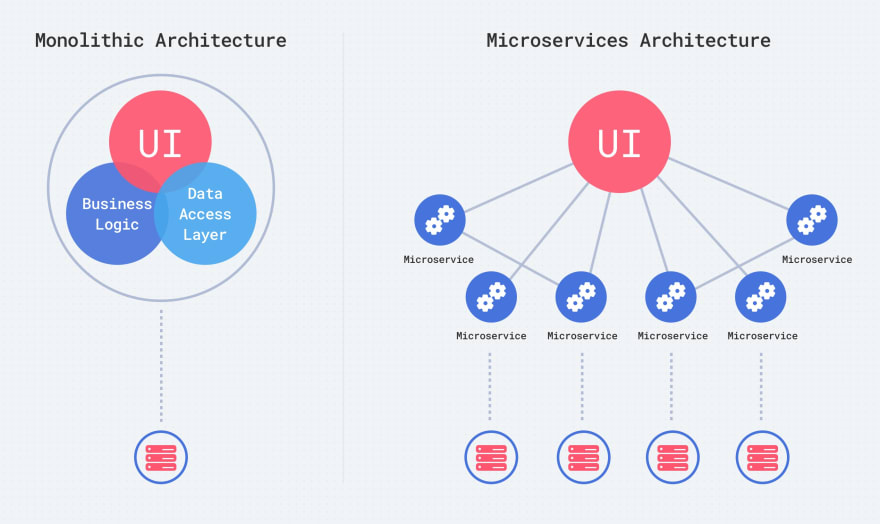Understanding the Basics: Microservices vs. Monolithic Architecture
Microservices and monolithic architectures are two popular approaches to building software applications. In a monolithic architecture, all components of the application are interconnected and run as a single process. This design can be simpler to implement and manage for small-scale projects. On the other hand, microservices architecture decomposes the application into smaller, loosely coupled services that communicate through APIs. Each service can be developed, deployed, and scaled independently, making it a more flexible and adaptable solution for large-scale projects.
In this article, we will provide an in-depth comparison of microservices vs. monolithic architectures, discussing their pros, cons, and ideal use cases to help you make informed decisions for your projects.
Monolithic Architecture: Pros and Cons
Monolithic architecture is a traditional approach to software development where all components of an application are combined into a single unit. This design offers several advantages, including:
- Simplicity: With all components interconnected, monolithic applications are generally easier to develop and manage for small-scale projects.
- Performance: Since all components run within the same process, monolithic architecture can provide better performance than microservices architecture.
However, monolithic architecture also has some disadvantages, particularly for large-scale projects:
- Difficulty in scaling: Scaling a monolithic application requires scaling the entire application, which can be inefficient and resource-intensive.
- Maintainability: As monolithic applications grow, maintaining and updating them can become increasingly challenging, leading to higher development costs and longer time-to-market.
- Limited flexibility: Monolithic architecture can make it difficult to adopt new technologies or integrate with external services, as changes often require modifying the entire application.
Despite these challenges, monolithic architecture remains a suitable choice for certain scenarios, such as small-scale projects or applications with simple, interconnected components.
Microservices Architecture: Pros and Cons
Microservices architecture is a modern approach to software development that decomposes an application into smaller, loosely coupled services. This design offers several benefits, including:
- Scalability: Microservices architecture enables independent scaling of each service, allowing for more efficient resource utilization and improved performance under heavy loads.
- Independent deployment: Each microservice can be developed, tested, and deployed independently, reducing the time-to-market and minimizing the impact of updates on the entire system.
- Technology diversity: Microservices architecture allows teams to use different technologies, frameworks, and tools for each service, fostering innovation and leveraging the strengths of various technologies.
However, microservices architecture also introduces some challenges:
- Managing inter-service communication: Microservices need to communicate with each other through APIs, which can increase the complexity of the system and require more sophisticated monitoring and management tools.
- Data consistency: Ensuring data consistency across multiple services can be challenging, as distributed transactions and eventual consistency models need to be carefully managed.
- Increased operational complexity: Managing a fleet of microservices requires more sophisticated DevOps practices, such as container orchestration, service discovery, and load balancing.
Despite these challenges, microservices architecture can be an excellent choice for large-scale projects, applications requiring high scalability, or teams with diverse technology skill sets.
When to Choose Monolithic Architecture
Monolithic architecture is a suitable choice for certain scenarios, including:
- Small-scale projects: For applications with limited functionality and a small number of users, monolithic architecture can provide a simple, easy-to-manage solution.
- Applications with simple, interconnected components: If the application’s components have strong dependencies and interactions, a monolithic architecture can help simplify development and maintenance.
- Tight deadlines and limited resources: Monolithic architecture can be quicker to develop and deploy, making it a better choice for projects with tight deadlines or limited resources.
However, it’s essential to consider the long-term implications of choosing a monolithic architecture, as scaling and maintaining large applications can become increasingly challenging over time. If you anticipate your application growing in size or complexity, it may be worthwhile to evaluate microservices architecture as an alternative.
When to Choose Microservices Architecture
Microservices architecture is an ideal choice for certain scenarios, such as:
- Large-scale projects: For applications with extensive functionality and a large number of users, microservices architecture can help manage complexity and improve maintainability.
- Applications requiring high scalability: Microservices architecture enables independent scaling of each service, allowing for more efficient resource utilization and improved performance under heavy loads.
- Teams with diverse technology skill sets: Microservices architecture allows teams to use different technologies, frameworks, and tools for each service, fostering innovation and leveraging the strengths of various technologies.
- Frequent updates and deployments: Microservices architecture enables independent deployment of each service, reducing the time-to-market and minimizing the impact of updates on the entire system.
However, it’s essential to consider the challenges associated with microservices architecture, such as managing inter-service communication and data consistency. If your team is not experienced in managing distributed systems, it may be beneficial to start with a monolithic architecture and gradually transition to microservices as your team gains the necessary skills and experience.
Strategies for Transitioning from Monolithic to Microservices
Transitioning from a monolithic to a microservices architecture can be challenging, but several best practices can help ensure a smooth transition:
- Gradually decompose the monolith: Instead of attempting to convert the entire monolith into microservices at once, start by identifying and extracting individual services from the monolith. This approach minimizes disruption and allows teams to gain experience with microservices gradually.
- Implement API gateways: API gateways can help manage inter-service communication and provide a unified entry point for external clients. By routing requests to the appropriate services, API gateways can simplify the client-side logic and improve overall system resilience.
- Establish a robust DevOps culture: Managing a microservices architecture requires a strong DevOps culture, with a focus on automation, continuous integration, and continuous delivery. Invest in tools and processes that enable your team to manage and deploy microservices efficiently.
- Monitor and analyze performance: As the number of microservices increases, so does the complexity of the system. Implement monitoring and analysis tools that provide insights into the performance and behavior of individual services and the overall system.
Transitioning from a monolithic to a microservices architecture requires careful planning and execution. By following best practices and investing in the right tools and processes, teams can successfully navigate this transition and reap the benefits of a more scalable, maintainable, and flexible system.
Real-World Examples: Successful Microservices and Monolithic Implementations
Both monolithic and microservices architectures have been successfully implemented in various projects. Here are some examples:
Monolithic Architecture Success Stories
Example 1: A small e-commerce platform – A startup developed a simple e-commerce platform using a monolithic architecture. The application was easy to manage, and the team could quickly implement new features without worrying about inter-service communication or data consistency.
Microservices Architecture Success Stories
Example 1: A large online marketplace – A well-known online marketplace adopted a microservices architecture to manage its complex, ever-evolving system. By decomposing the application into smaller, independent services, the company improved its scalability, maintainability, and deployment speed.
Example 2: A real-time analytics platform – A real-time analytics platform leveraged microservices architecture to enable independent scaling of its data processing and visualization components. This approach allowed the company to handle massive amounts of data and provide low-latency insights to its users.
When considering monolithic vs. microservices architecture, it’s essential to evaluate the specific needs and constraints of your project. Both approaches have their merits and can lead to successful implementations in the right scenarios. By understanding the advantages and disadvantages of each architecture, you can make an informed decision and set your project up for long-term success.
Making an Informed Decision: Monolithic vs. Microservices
When deciding between monolithic and microservices architectures, consider the following recommendations based on your project’s requirements and constraints:
Choose Monolithic Architecture if:
- Your project is small-scale and has simple, interconnected components.
- You want to minimize the complexity of your system.
- Performance is a critical factor, and you can achieve better performance with a monolithic architecture.
- Your team is small and has limited experience with distributed systems.
Choose Microservices Architecture if:
- Your project is large-scale and requires high scalability.
- You need to deploy features or updates independently.
- Your team has diverse technology skill sets and can benefit from using different tools and frameworks for each service.
- You are willing to invest in managing inter-service communication and data consistency.
In some cases, it might make sense to start with a monolithic architecture and transition to microservices as your project grows and evolves. By understanding the advantages and disadvantages of each architecture, you can make informed decisions and set your project up for long-term success.





